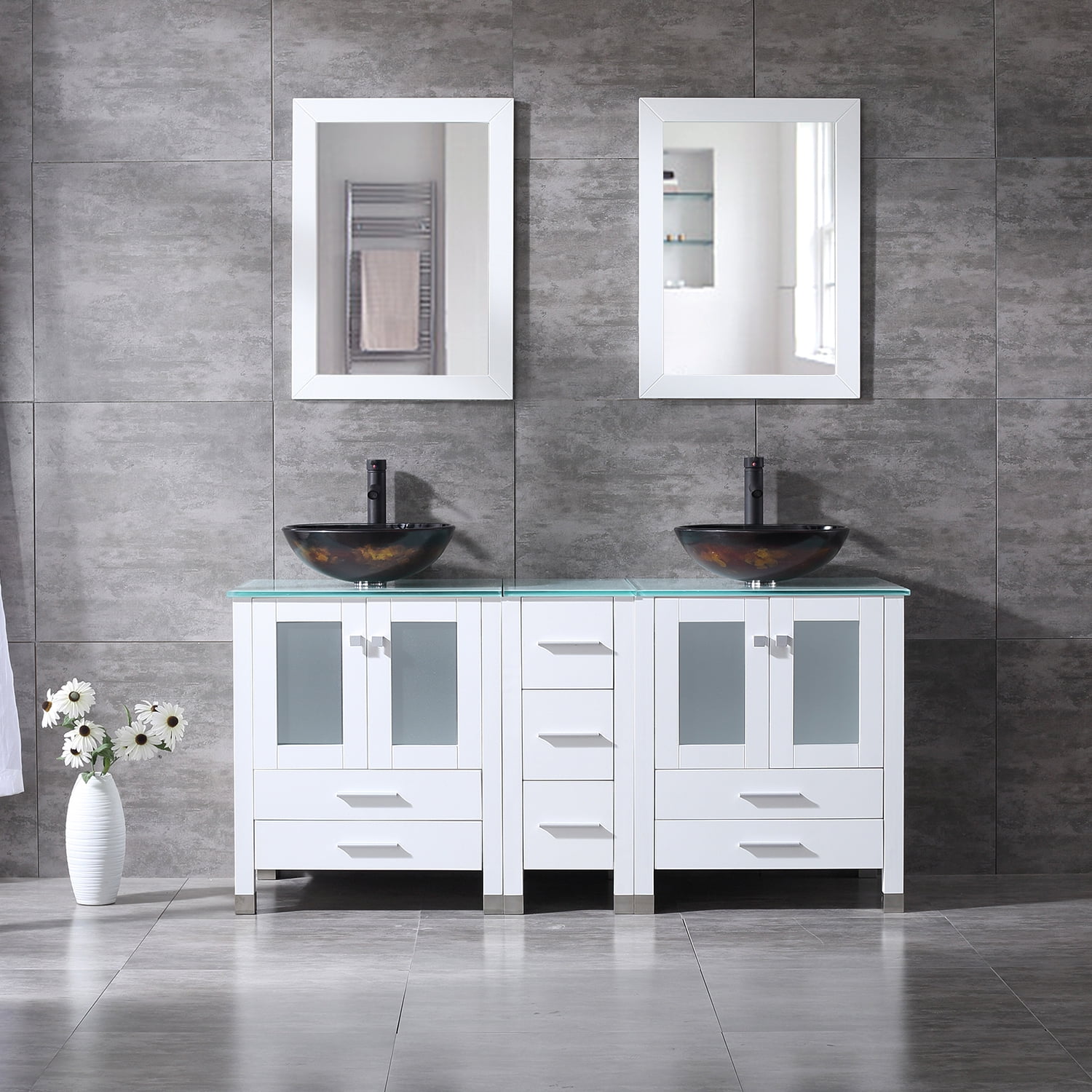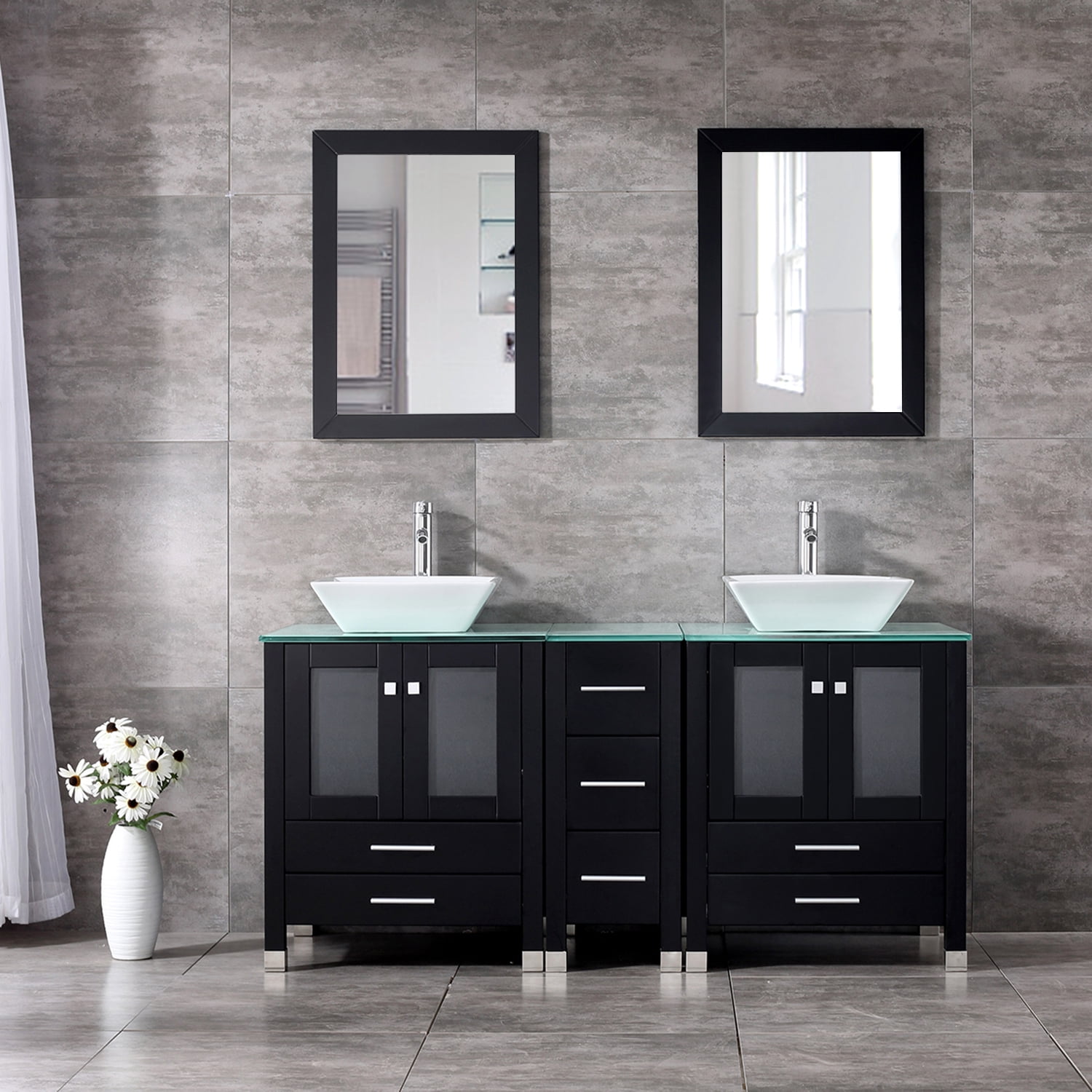Glass Bowl Sink Vanity Cabinet

A glass bowl sink vanity cabinet seamlessly blends style and functionality, offering a modern and sophisticated touch to any bathroom. The sleek design of a glass bowl sink, coupled with the practicality of a vanity cabinet, creates a harmonious and aesthetically pleasing space.
Benefits of Glass Bowl Sinks, Glass bowl sink vanity cabinet
Glass bowl sinks bring a unique set of advantages to bathroom design, enhancing both aesthetics and practicality. Their smooth, non-porous surface makes them incredibly easy to clean, preventing the accumulation of dirt and bacteria. This durability, coupled with their resistance to scratches and stains, ensures a long-lasting and hygienic sink. Moreover, the modern appeal of glass bowl sinks adds a touch of elegance and sophistication to any bathroom, making them a popular choice for contemporary and minimalist designs.
Types of Glass Bowl Sinks
Glass bowl sinks come in a wide variety of styles, materials, and sizes, catering to diverse bathroom aesthetics and functional needs.
Glass Materials
- Tempered Glass: Tempered glass is the most common material used for glass bowl sinks. It is incredibly durable, resistant to heat and impact, and less prone to shattering than regular glass. This makes it a safe and practical choice for everyday use.
- Borosilicate Glass: This type of glass is known for its high heat resistance and durability. It is often used for high-end glass bowl sinks, offering a premium look and feel.
- Acrylic Glass: Acrylic glass is a lightweight and shatter-resistant material. It is often used for budget-friendly glass bowl sinks, offering a sleek and modern aesthetic at an affordable price.
Shapes and Sizes
- Round: Round glass bowl sinks are a classic choice, offering a sleek and minimalist look. They are available in various sizes, from compact options for small bathrooms to larger bowls for spacious vanities.
- Square: Square glass bowl sinks bring a contemporary and geometric touch to bathroom design. They are often paired with modern vanity cabinets and fixtures, creating a cohesive and stylish look.
- Oval: Oval glass bowl sinks offer a blend of classic and contemporary aesthetics. They provide a spacious basin while maintaining a sleek and elegant profile.
Suitability for Bathroom Styles
- Contemporary: Glass bowl sinks are a natural fit for contemporary bathrooms. Their sleek lines, minimalist design, and modern materials create a sophisticated and stylish ambiance.
- Minimalist: The simple and clean design of glass bowl sinks aligns perfectly with minimalist aesthetics. They help to create a sense of spaciousness and tranquility in the bathroom.
- Transitional: Glass bowl sinks can also be incorporated into transitional bathroom designs, offering a bridge between traditional and modern styles. Their sleek lines and neutral colors blend seamlessly with various design elements.
Materials and Construction

Glass bowl sink vanity cabinets are often a focal point in a bathroom, blending style and functionality. Their construction involves a careful selection of materials and meticulous assembly to ensure durability and longevity.
Materials Used in Glass Bowl Sink Vanity Cabinets
The materials used in constructing glass bowl sink vanity cabinets play a crucial role in their overall appearance, durability, and cost. Common materials include wood, metal, and stone.
- Wood: Wood is a popular choice for vanity cabinets due to its natural beauty, versatility, and relative affordability. Common wood species used include oak, maple, cherry, and walnut. Wood cabinets can be stained or painted to match any bathroom decor. However, wood is susceptible to moisture damage, requiring proper sealing and maintenance to prevent warping or rotting.
- Metal: Metal, particularly stainless steel, is a durable and hygienic option for vanity cabinets. Stainless steel is resistant to rust, scratches, and stains, making it easy to clean. Metal cabinets often feature a sleek and modern aesthetic. However, metal can be more expensive than wood and may be susceptible to dents or scratches if not handled carefully.
- Stone: Stone, such as granite or marble, offers a luxurious and elegant look for vanity cabinets. Stone is durable, scratch-resistant, and heat-resistant. However, stone is also the most expensive material option and requires specialized installation and maintenance. It can be prone to etching from acidic substances and requires regular sealing to prevent staining.
Construction Process
The construction of a glass bowl sink vanity cabinet involves several steps:
- Cabinet Assembly: The cabinet frame is typically constructed from wood or metal. The frame is assembled using various joinery techniques, such as mortise and tenon, dovetail, or pocket hole joinery. The cabinet frame is then covered with plywood or MDF to create a smooth and sturdy surface.
- Sink Installation: The glass bowl sink is typically installed on top of the vanity countertop. The sink is secured to the countertop using specialized adhesives or clamps. A drain hole is pre-drilled in the countertop to accommodate the sink drain.
- Countertop Installation: The countertop can be made from various materials, including wood, laminate, stone, or quartz. The countertop is secured to the cabinet frame using brackets or screws. The countertop edges are often finished with a decorative trim or molding.
- Surface Finishing: The final step involves finishing the surface of the vanity cabinet. Wood cabinets are typically stained or painted, while metal cabinets may be polished or powder-coated. Stone countertops are often sealed to prevent staining and enhance their natural beauty.
Durability and Longevity
The durability and longevity of a glass bowl sink vanity cabinet depend on the materials used and the quality of construction.
- Wood Cabinets: Wood cabinets can last for many years with proper care and maintenance. Regular sealing and cleaning can help prevent moisture damage and preserve the wood’s finish. However, wood is susceptible to scratches and dents, so it is important to handle it with care.
- Metal Cabinets: Metal cabinets are known for their durability and resistance to moisture damage. Stainless steel is particularly resistant to rust and corrosion, making it a long-lasting option. However, metal cabinets can be susceptible to dents and scratches.
- Stone Countertops: Stone countertops are highly durable and resistant to scratches, heat, and stains. However, stone can be susceptible to etching from acidic substances, and it requires regular sealing to prevent staining.
Installation and Maintenance

Installing and maintaining a glass bowl sink vanity cabinet requires a careful approach to ensure proper functionality and longevity. This section will guide you through the installation process, highlighting crucial steps and offering maintenance tips to keep your vanity looking its best.
Installation
Installing a glass bowl sink vanity cabinet involves connecting plumbing, mounting the cabinet, and installing the sink. This process requires some basic plumbing and carpentry skills, but with careful planning and attention to detail, it can be a manageable DIY project.
- Prepare the Space: Before starting the installation, clear the area around the vanity, including removing any existing fixtures or furniture. Ensure you have access to water and power sources for the plumbing and electrical connections.
- Install the Plumbing: Connect the vanity’s drain line to the existing waste pipe, ensuring a secure and leak-proof connection. Connect the water supply lines to the vanity’s faucet, making sure to tighten all connections to prevent leaks.
- Mount the Cabinet: Carefully position the vanity against the wall, ensuring it is level and aligned with the surrounding fixtures. Use the provided mounting hardware to secure the cabinet to the wall, ensuring it is sturdy and stable.
- Install the Sink: Place the glass bowl sink on the vanity countertop, aligning it with the faucet and drain. Use the provided mounting hardware and sealant to secure the sink to the countertop, creating a watertight seal. Ensure the sink is properly centered and level for optimal aesthetics and functionality.
Maintenance
Proper maintenance is essential to keep your glass bowl sink vanity cabinet looking its best and extending its lifespan. Regular cleaning and stain removal techniques can help prevent damage and preserve the beauty of your vanity.
- Regular Cleaning: Clean the vanity countertop and sink regularly using a mild, non-abrasive cleaner. Avoid harsh chemicals or abrasive cleaners that can damage the glass or finish.
- Stain Removal: For stubborn stains, use a specialized glass cleaner or a mixture of baking soda and water. Apply the cleaner to the stained area and gently scrub with a soft cloth. Avoid using abrasive cleaners or scouring pads that can scratch the glass surface.
- Preventative Measures: To prevent water damage and staining, dry the countertop and sink thoroughly after each use. Wipe up spills immediately to prevent them from setting. Regularly inspect the cabinet for signs of damage or wear, and address any issues promptly.
Troubleshooting
During the installation and maintenance process, you may encounter challenges that require troubleshooting. Common issues include leaks, loose connections, and damage to the vanity or sink.
- Leaks: If you notice leaks, check all plumbing connections for tightness. Ensure the drain line is properly connected to the waste pipe, and the water supply lines are securely attached to the faucet. Tighten any loose connections and re-apply sealant if necessary.
- Loose Connections: If the cabinet or sink feels loose, check the mounting hardware for tightness. Re-tighten any loose screws or bolts. If the problem persists, consult a professional for assistance.
- Damage: If you notice damage to the vanity or sink, try to repair it promptly. For minor scratches, use a glass polish to restore the surface. For more significant damage, contact a professional for repairs or replacement.
Okay, so you’re thinking about a glass bowl sink vanity cabinet, right? That’s totally chic and modern. But have you considered adding some vintage vibes with a wood china cabinet with glass doors ? It’s like a time capsule of your grandma’s good china, but in a totally cool way.
And think of the storage space! It’s like a whole other dimension for your bathroom essentials, and you can even display your favorite bath bombs or candles.
A glass bowl sink vanity cabinet can really elevate your bathroom’s vibe, but you know what else is super chic? Adding some leaded glass inserts for kitchen cabinets – it’s like bringing a little bit of old-world charm to your kitchen, and it totally complements a sleek glass bowl sink vanity cabinet in your bathroom.
Talk about a statement-making combo!
